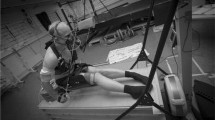Abstract
To determine whether power-velocity relationships obtained on a nonisokinetic cycle ergometer could be related to muscle fibre type composition, ten healthy specifically trained subjects (eight men and two women) performed brief periods of maximal cycling on a friction loaded cycle ergometer. Frictional force and flywheel velocity were recorded at a sampling frequency of 200 Hz. Power output was computed as the product of velocity and inertial plus frictional forces. Force, velocity and power were averaged over each down stroke. Muscle fibre content was determined by biopsy of the vastus lateralis muscle. Maximal down stroke power [14.36 (SD 2.37)W·kg−1] and velocity at maximal power [120 (SD 8) rpm] were in accordance with previous results obtained on an isokinetic cycle ergometer. The proportion of fast twitch fibres expressed in terms of cross sectional area was related to optimal velocity (r = 0.88, P < 0.001), to squat jump performance (r = 0.78, P < 0.01) and tended to be related to maximal power expressed per kilogram of body mass (r = 0.60, P = 0.06). Squat jump performance was also related to cycling maximal power expressed per kilogram of body mass (r = 0.87, P < 0.01) and to optimal velocity (r = 0.86, P < 0.01). All these data suggest that the nonisokinetic cycle ergometer is a good tool with which to evaluate the relative contribution of type II fibres to maximal power output. Furthermore, the strong correlation obtained demonstrated that optimal velocity, when related to training status, would appear to be the most accurate parameter to explore the fibre composition of the knee extensor muscle.
Similar content being viewed by others
References
Aagaard P, Simonsen EB, Trolle M, Bangsbø J, Klausen K (1994) Moment and power generation during maximal knee extensions performed at low and high speeds. Eur J Appl Physiol 69:376–381
Arsac LM, Belli A, Lacour J-R (1996) Muscle function in brief maximal exercise further visited by accurate measurements on a friction loaded cycle ergometer. Eur J Appl Physiol
Bosco C, Komi PV (1979) Mechanical characteristics and fiber composition of human leg extensor muscles. Eur J Appl Physiol 41:275–284
Bosco C, Komi PV, Sinkkonen K (1980) Mechanical power, net efficiency and muscle structure in male and female middle-distance runners. Scand J Sports Sci 2:47–51
Bosco C, Luhtanen P, Komi PV (1983) A simple method for measurement of mechanical power in jumping. Eur J Appl Physiol 50:273–282
Bosco C, Komi PV, Bosco E, Nicol C, Pulvirenti G, Caruso I (1994) Influence of training on mechanical and biochemical profiles of athlete's muscles. Coaching Sport Sci J 1(1):8–13
Davies CTM, Wemyss-holden J, Young K (1984) Measurement of short term power output: comparison between cycling and jumping. Ergonomics 27:285–296
Denis C, Linossier MT, Dormois D, et al (1992) Power and metabolic responses during supramaximal exercise in 100-m and 800-m runners. Scand J Med Sci Sports 2:62–69
Faulkner JA, Claflin DR, McCully KK (1984) Power output of fast and slow fibers from human skeletal muscles. In: Jones NL, McCartney N, McComas AJ (eds) Human muscle power. Human Kinetics Champaign, Ill., pp 81–91
Fenn WO, Brody H, Petrilli A (1931) The tension developed by human muscles at different velocities of shortening. Am J Physiol 97:1–14
Gregor RJ, Edgerton R, Perrine JJ, Campion DS, Debus C (1979) Torque-velocity relationships and muscle fiber composition in elite female athletes. J Appl Physiol Respir Environ Exerc Physiol 47:388–392
Lakomy HKA (1986) Measurement of work and power output using friction-loaded cycle ergometers. Ergonomics 29:509–517
McCartney N, Heigenhauser GJF, Jones NL (1983) Power output and fatigue of human muscle in maximal cycling exercise. J Appl Physiol Respir Environ Exerc Physiol 55:218–224
McCartney N, Obminski G, Heigenhauser GJF (1985) Torque-velocity relationship in isokinetic cycling exercise. J Appl Physiol 58:1459–1462
Perrine JJ, Edgerton VR (1978) Muscle force-velocity and powervelocity relationships under isokinetic loading. Med Sci Sports 10:159–166
Sargeant AJ (1994) Human power output and muscle fatigue. Int J Sports Med 15:116–121
Sargeant AJ, Hoinville E, Young A (1981) Maximum leg force and power output during short-term dynamic exercise. J Appl Physiol Respir Environ Exerc Physiol 51:1175–1182
Sargeant AJ, Dolan P, Young A (1984) Optimal velocity for maximal short-term (anaerobic) power output in cycling. Int J Sports Med 5[Suppl]:124–125
Thorstensson A, Grimby G, Karlsson J (1976) Force-velocity relations and fiber composition in human knee extensor muscles. J Appl Physiol 40:12–16
Williams JH, Barnes WS, Signorile JF (1988) A constant load ergometer for measuring peak power output and fatigue. J Appl Physiol 65:2343–2348
Author information
Authors and Affiliations
Rights and permissions
About this article
Cite this article
Hautier, C.A., Linossier, M.T., Belli, A. et al. Optimal velocity for maximal power production in non-isokinetic cycling is related to muscle fibre type composition. Europ. J. Appl. Physiol. 74, 114–118 (1996). https://doi.org/10.1007/BF00376503
Accepted:
Issue Date:
DOI: https://doi.org/10.1007/BF00376503




